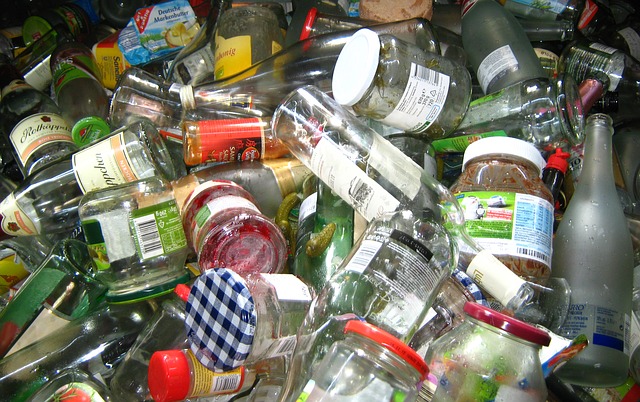
In the United States, approximately 70% of everyday waste is recyclable. Of this 70%, Americans only recycle about 30%. This means that more than half of the waste that could be recycled in one way or another is instead ending up in landfills across the country. Landfills are quickly becoming overfilled with waste that cannot simply disintegrate in the landfill within our lifetimes. One plastic water bottle, for instance, takes around 450 years to disintegrate. With such extended times for disintegration to take place, there is no room for further waste. When landfills become overcrowded and filled with items that are potentially hazardous, they begin to produce a harmful gas that seeps into the air and the ground. Recycling paper, plastic, and glass can save mass amounts of harmful products from making their way to landfills. Not only does recycling eliminate excess waste in landfills, but it also saves trees and energy that are used to create plastic and glass. On top of those benefits, recycling and environmentally friendly practices, such as composting and re-using products, can save a lot of money for an average household.
Traditional Methods of Recycling
Traditional types of recycling are the most common. Items are separated by material, labels are removed, and the products are sorted by material type into bins. When the bins are full, they are picked up by a recycling company and then taken to a facility where they can be recycled into new products. Paper, plastic, and glass are all materials that fall into traditional recycling methods.
Paper
Recycling paper products is a very direct way of helping the environment. When paper products are recycled, it prevents a huge amount of trees from being cut down and turned into new products. Most people assume that only newspapers and actual pieces of paper can be recycled in the paper category, but a lot of people often fail to realize that this category consists of much more. Egg cartons, coffee filters, masking tape, and even some bandages, for example, can all be recycled into new paper products. There are many resources that further detail which paper products can be recycled through the process of grinding and binding of the fibers of paper.
- Paper Recycling Facts: The University of Southern Indiana has gathered factual information about the benefits of recycling paper products versus throwing them into the trash.
- How Many Times Can You Recycle Paper?: Everyone has seen previously recycled paper for sale, but can it be recycled yet again after use? This resource answers commonly asked questions about continually recycled materials.
- Paper Recycling Experiment (PDF): This experiment teaches children how paper is recycled.
- Recycling Newspaper for Mulch (PDF): People often have a lot of previously read newspapers sitting around their homes. This tutorial offers an approach to recycling traditionally recycled newsprint by using the paper as mulch in a home garden or flower bed.
- Paper Recycling Notes: While a lot of paper can be recycled, it is important to note that some paper products (such as tissues) are not recyclable. This collection of notes explains and clears up some confusing information about recycling paper products.
Plastic
The plastic category of recycling can be difficult to understand, as most plastic products contain recycling numbers and codes. These codes identify the type of plastic that was used to create the product, which simplifies the process for those who sort plastic in recycling facilities. It also helps ensure that when the plastic material is melted down and turned into pellets for further use, it will end up in the correct manufacturing plant, where it can be used in the correct manner. Plastic water bottles, garbage bags, disposable diapers, and plastic plates and cups are among the most commonly recycled plastic products.
- Frequently Asked Questions About Plastic Recycling: A FAQ page addresses some of the most frequently asked questions about recycling plastic materials.
- Recycling Plastic Complications (PDF): Plastic is one of the more difficult substances to recycle. In this newsletter, the complications of recycling plastic are discussed in detail to help recyclers gain a better understanding of the process.
- What Do Those Recycling Numbers Mean?: Most people at some point have noticed various numbers with recycling symbols featured on different types of plastic products. This resource explains what these numbers mean.
- What Happens to All That Plastic?: Plastic that is sent to landfills often causes overfilling problems; this resource takes a look at what happens to plastic when it is recycled versus when it is in a landfill.
- Recycle This, Not That: This guide provides a look at which plastic items are recyclable and which are not.
Glass
Glass products can be recycled as well, but not all recycling facilities accept glass due to the nature in which it must be handled and recycled. Those places that do accept glass for recycling generally accept baby food jars, glass beverage bottles, and even products that contain colored glass. Glass is unique in that it can be recycled endlessly without losing any quality or clarity. Colored glass can also be recycled endlessly into new colored glass products or even colored sand. The process is fairly simple for those facilities that have proper equipment, and a recycled glass product can go from the recycling facility to being back on a shelf in a store in less than one month.
- The Recycling Process After Collection – Glass: Many people wonder what happens to their recyclable glass products after they are collected. Here, they can find all the answers to their recycling process questions.
- What Can I Recycle?: The majority of glass products can be recycled, but it is always a good idea to check with a reliable resource before dropping items into recycling receptacles.
- How Do I Recycle? (PDF): This is a how-to guide that informs people of the recycling process before collection with glass and other products.
- Kids, Recycle Glass: Teaching children about how to recycle is important; this resource explains the glass recycling process in kid-friendly terms.
- How to Recycle/Dispose of Glass Bottles and Jars: It is important to note that not all recycling facilities accept glass for recycling. If there are no local glass recycling facilities, it may be possible to find other ways to dispose of them without adding unnecessarily to landfills.
Getting Creative with Recycling
Creative purposes for recycling are not only good for the environment but for a budget as well. Recycling does not always mean that a new purpose is found for a product or that it is turned into something else. Clothing, for instance, can simply be donated and used by someone else. “Freecycling” is a form of recycling just about anything by giving it to someone else who has a purpose for it. For instance, a vacuum that still works but is no longer needed in a household can be given to someone without a vacuum cleaner, and that is also a form of recycling. Using recycled materials for artwork is also a great way to recycle. This practice is very common in elementary schools, as children create quite a bit of artwork. Creating a picture out of torn-up and glued newspaper pieces, for example, is a creative way to extend the life of a newspaper beyond its original use. Finding creative uses for items that can or cannot be recycled into new products is a great way to eliminate the amount of waste that makes its way to the landfill.
Clothes
Whether clothing has been outgrown due to size or simply has gone out of fashion, there is a way to put any type of fabric to use again. Donating clothes to those who are less fortunate is a great way to get rid of old clothing that also helps another person. If the clothing is ripped or torn and is unwearable, it can be transformed into a new blanket or even a pillowcase. The possibilities with recycled clothing and fabric materials are endless with a little creativity.
- Reuse and Recycle Textiles: There are many options for reusing clothing and fabric; this resource mentions options for both reusing and recycling textiles.
- Even Torn & Stained Clothing Can Be Recycled (PDF): Even for clothing that is not in good shape, a recyclable use can be found for all fabrics.
- Donating Clothes: One of the oldest and simplest ways to recycle old clothing is to donate it to a local homeless shelter or organization for the needy.
- Textile Recycling Programs: Donating or recycling old clothes and textiles immensely benefits communities and the environment; this resource details the benefits of recycling textiles.
- Recycled Duds: This resource provides in-depth information on the benefits of recycling clothing, not only for the environment but for one’s budget as well.
Freecycle
Freecycling is a way of life for those who are worried about the condition of the environment as well as those who are looking to save money. Freecycling is the practice of giving away old items to people who can find new uses for them. It is essentially the old concept of “one man’s trash is another man’s treasure.” There are large communities of people that freecycle across the country. People who need items get them for free, saving a large amount of money over time, and the people who are giving them away quickly remove clutter in their homes without adding to landfills. This practice is beneficial for everyone involved and the environment.
- Community Spirit Benefits From Freecycling: A University of California, Berkeley, study showed that trading unwanted goods in the community fosters community spirit.
- No Money Necessary with Freecycling: Freecycling is defined and described in this article.
- The Freecycle Network: The Freecycle Network is a large community of freecyclers.
- Recycle the World: This site offers another place where freecyclers can exchange goods.
- Freecycle Forever: A community that teaches other members how to recycle old items through freecycling practices.
Make Art
The practice of making art from recycled items is popular in the art community as well as in schools. Artists often participate in community-sponsored recycled art contests that can provide everyone with an equal opportunity, as they are spared the cost of materials and art supplies. In schools, especially early elementary classes, schools save money by asking for recycled donations. Cardboard paper towel and toilet paper rolls, along with newspapers and plastic buttons, are frequently reconstructed in elementary school art classes into new masterpieces. Reusing these items saves the cost of using more expensive materials and also keeps these items that would otherwise be thrown away from cluttering up trash facilities.
- Recyclart: Recyclart is an organization that focuses on reusing or repurposing artwork for new purposes.
- Recycled Holiday Crafts (PDF): This document contains ideas for how kids can turn household junk for pickup into neat holiday decorations.
- Recycled Arts and Crafts: Recycled arts and crafts can be a great way to teach children and adults alike about the many uses for previously used items. This guide offers a wide array of recycled arts and crafts.
- Going Green Lesson Plan: This lesson plan maps out a way for teachers to show children how to reuse items to make art while helping the environment.
- Recycled Art Raises Awareness About Waste: Donating to art-based organizations and viewing the completed art projects made from recycled materials is a way to raise awareness about saving items from landfills.
Composting
Composting is the act of piling natural waste products together and letting them decompose in a pile. When the waste products decompose, all of the nutrients from the waste are essentially given back to the soil. This creates a very rich soil that can be used for use in home gardens or even on farms. The use of composted soil saves people the cost of getting rid of wasted food products as well as the cost of expensive soil enhancers and pesticides.
- Composting in the Home Garden
- Environmental Sustainability: Composting and Recycling
- How to Build a Compost Bin
- How Compost Happens
- Compost Process
Worm Composting
Worm composting is essentially the same practice as regular composting, only it involves the use of earth worms. The use of live worms aids in the decomposition process, which is ideal for those with small yards or a large amount of food waste. The worms eat the food waste, and as it passes through their bodies, it is turned into a form of compost called vermicompost. The composting process moves along much more quickly with the use of worms, and the compost can be used in the same soil-enriching way as regular compost.
- Worm Composting Basics
- Cheap and Easy Worm Composting Bin
- Worms Can Recycle Your Garbage
- Composting with Worms (PDF)
- Worm Composting Tips
More Recycling Resources
- Recycle City: Teaching future generations the importance of recycling early in their lives so that recycling will continue into future generations. Recycle City provides various games & interactive lessons to teach children about recycling and its importance to Earth and communities.
- Why Recycle? (PDF):This document is a comprehensive resource that explains the various benefits of recycling for the environment.
- Recycling and Waste Reduction: Throwing away materials that are not easily broken down in landfills attributes to overfilling of landfills. Using the information provided in this guide, one can easily discover ways to keep waste out of landfills through recycling.
- Recycling Facts: This website about recycling clearly outlines the various types of recyclable materials and offers a vast amount of information and random facts about the benefits of recycling each type of material.
- The Ultimate Recycling List: Many people do not recycle certain items because they are simply unaware of what can and cannot be recycled. This list contains many items with information on whether they are recyclable or if they can be used for other purposes to cut down on the amount of waste in landfills.
 Going Green: Major Renovations with Multiple Rooms
Going Green: Major Renovations with Multiple Rooms  5 Green Renovation Terms
5 Green Renovation Terms  Remodeling? Why You Need a Residential Designer
Remodeling? Why You Need a Residential Designer  HomeAdvisor Trend Watch: Major Basement Remodels on the Rise
HomeAdvisor Trend Watch: Major Basement Remodels on the Rise  Going Green in Your Home
Going Green in Your Home 

Are You Familiar With This Topic? Share Your Experience.